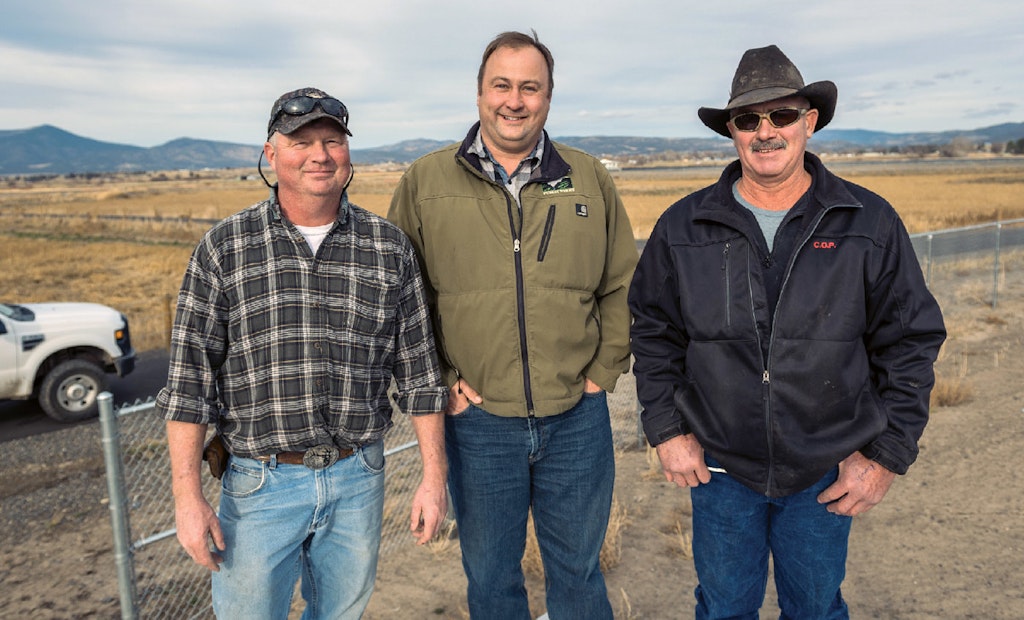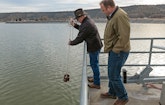
The Prineville team includes, from left, Chris Weaver, utility worker; Eric Klann, city engineer; and Daren Holliday, treatment plant operator. The Crooked River Wetland Project wetland cells are in the background.
Faced with borrowing $62 million for a new wastewater treatment plant, the city of Prineville, Oregon, wanted an alternative. Community leaders found it in the $7.7 million Crooked River Wetland Complex, which now receives a large share of the effluent from the city’s 2.31 mgd (design) facultative lagoon treatment plant.
After several grants, the city’s share of the wetlands’ cost was $4.75 million. That means the city saved $57.25 million over the cost of the mechanical treatment plant an engineering firm had recommended in a facility master plan. The benefits are significant: reliable treatment and affordable rates that help make the city attractive to new residents and businesses. Eric Klann, P.E., city engineer, expects the existing treatment lagoons and the wetlands to meet the city’s needs for 30 years or more.
The project, created with extensive community participation, includes a network of recreational trails and a set of educational kiosks created with help from school children and teachers. “Very rarely do you get an entire community excited about a wastewater treatment plant expansion,” Klann says. “We were able to get the community excited about this one because of the ancillary benefits.”
For its effort, the city received the 2016 Wastewater Project of the Year award from the Eastern Oregon Region American Water Works Association, and a 2017 Outstanding Project award from the Oregon Association of Clean Water Agencies. In addition, Klann received a 2017 Conservationist of the Year award from the East Cascades Audubon Society.
Planning for growth
Prineville, a city of about 9,600 in central Oregon’s high desert region, grew up in the timber industry, which faded in the 1960s. Around that time, the city constructed its first partially aerated facultative lagoon treatment plant. By 2000, that facility was running out of capacity. A second lagoon system was completed in 2004 at a cost of $14 million. Along with it came a series of sharp sewer rate increases, from $15 to $51 per month by 2008, that caused political upheaval.
Starting in 2005, the city saw a boom in residential development, from an average of about 20 new homes per year to 300. “The city had a facility master plan update done,” Klann says. “It said, ‘Prineville, you’re going to become a big city, and lagoons are something little cities do. You need to look at a mechanical treatment process.’” The cost was estimated at $62 million.
Klann, born and raised in Prineville, became its first city engineer in 2007. Meanwhile, anticipating the new plant, the city had raised the one-time wastewater System Development Charge for new homes from $3,800 to $9,147. “We were drastically higher than any of our neighboring communities,” Klann says. “It was tough if you wanted to come to Prineville and build a home. And imagine if you wanted to build a manufacturing facility that would have an impact on our treatment plant equivalent to 100 homes. That became a real hindrance to economic development.
“The City Council said, ‘This wastewater treatment plant is breaking our back — we can’t afford this plan.’ So the Public Works director and I started looking at other opportunities. Since the lagoons were working well and were very efficient to operate, we asked what we could do to extend their useful life. That’s where we came across the idea of effluent disposal wetlands.”
Research pays big
City personnel discovered that a community in eastern Oregon was discharging to an existing wetland complex managed by the Oregon Department of Fish and Wildlife. “The wetland was starved for water, and that city essentially negotiated a contract to provide its effluent to the wetland,” Klann says. “We investigated that and started doing due diligence to determine if we could construct our own wetlands.”
After a design process led by Anderson Perry & Associates, the city broke ground for the 120-acre wetland complex on Earth Day (April 22) in 2016. Construction contractor Rotschy completed the project, and the city held a grand opening on April 21, 2017.
Before designing the system, the consultants drilled 12 test wells and developed a groundwater model, which found that groundwater flowed to the Crooked River. In summer of 2016, the contractor moved 400,000 cubic yards of earth to create the wetland cells and enable flow-through by gravity. “Once the water reaches the beginning of the wetlands, we can move it wherever we want through a series of weirs,” Klann says. “We have no electricity costs and no pumps to maintain.
“The real beauty of the project was that the lagoons were already constructed and the majority already paid for. When we apply the effluent to the wetlands, that natural, living system consumes the organic loading that remains, polishing the water further.”
The low-cost solution enabled sewer rate reductions of 6.5 percent in 2011 and 4 percent in 2012. “Now that the project is done, we’re projecting rate increases of about 1.5 percent annually over the next 20 years,” Klann says. “That’s likely less than the increase in the Consumer Price Index.” The System Development Charge has decreased to $3,750.
Simple operation
Wastewater (about 1.1 mgd on average) is collected in about 50 miles of sewer lines. At the headworks, it passes through a bar screen (Huber Technology) and is then spilt between the two lagoon systems. About two-thirds flows to the original lagoon system for a 90-day treatment cycle, passing through a primary pond, a secondary pond, a rock filter and a chlorine contact basin. The balance goes to the lagoon built in 2004, with a similar process but with more intense aeration and a 45-day cycle. Both systems receive air from with Aire-O2 floating aeration units (Aeration Industries International).
Effluent from the plants can be sent to the city-owned Meadow Lakes golf course for irrigation, to 200 acres of city-owned pastureland, to discharge in the Crooked River, or to the wetlands. “We can discharge through the wetland system year-round,” Klann says. “On the golf course and pastureland, we can only discharge during summer. The wetland complex has no surface discharge to the Crooked River. The water seeps into the groundwater system and pops up in the bottom of the river.”
Engaging the community
To win support for the project, Klann organized a design process that encouraged community groups’ involvement. “Our pastureland was located along the Crooked River, and two small tributaries drop in near our site,” he says. “Steelhead have been reintroduced to our area, and the city was interested in making sure the reintroduction was successful.”
He helped organize four interest groups, focusing on river improvements (related to the steelhead), wetland habitat, education and recreation, and mosquito control. The design engineers held a kickoff meeting with the groups and then met with them at four stages of design to review progress, answer questions, and address issues.
A key attribute that emerged from the design, promoted by the Crook County Health Department, was arrangement of the wetland cells to accommodate 5.4 miles of trails, of which 3.2 miles are paved. An outer loop measures exactly 5 kilometers, and a paved loop measures exactly 3 kilometers. The site includes parking and a covered pavilion with restrooms.
“Having multiple interest groups involved really helped us when we went to fund the project,” Klann says. “We received more than $3 million in grants.” They included:
- U.S. Department of Agriculture Rural Development, $1,000,000
- Business Oregon’s Infrastructure Finance Authority, $750,000
- Confederated Tribes of Warm Springs and Portland General Electric, $825,000
- Oregon Watershed Enhancement Board, $538,417
- Oregon State Parks, $260,000
The work included improvements to about 2 miles of the Crooked River, removing channelization and restoring the stream to its natural meander. Klann’s personal favorite project component is a set of 13 educational kiosks. School classes selected topics such as pollinators, macroinvertebrates, and watersheds; studied their topics for about three months; and then created kiosk displays with help from professional graphic designers.
Simple to run
As for day-to-day work at the facility, that falls to Daren Holliday, treatment plant operator, and Chris Weaver, utility worker. They handle laboratory testing, maintenance of the aeration and pumping systems, distribution of water within the wetland complex, pastureland irrigation, and other tasks. The system easily meets its BOD and TSS permit limits of 10 mg/L in summer and 30 mg/L in winter, as measured in samples from groundwater wells between the wetland system and the Crooked River.
Klann sees Prineville’s project as potentially simple for other communities to replicate: “I didn’t want people in the future to go through the pain and anguish we experienced to get this project designed and permitted. So we’re doing a lot of testing and making all the data available to any community that would want to use it to see if such a project would work for them. I hope we can help other people have a little bit easier time.”
Conserving water
Wastewater isn’t the only area where Prineville, Oregon, has innovated. In nine years, the city reduced its nonrevenue water from almost 28 percent to 1.9 percent — from 172 million gallons in 2008 to 10 million gallons in 2016.
As a result, the city now produces less water from its groundwater wells than 10 years ago, yet it sells more water to customers. The amount of water saved would cover the high school football field to a depth of about 450 feet.
The city’s large water losses date back to a period of growth during World War II, when steel was scarce and many wooden water mains were installed. Not surprisingly, those mains eventually leaked. “At the time I came to work with the city in fall of 2007, the Public Works Department and the City Council made a concerted effort to start optimizing the system,” recalls Eric Klann, P.E., city engineer.
The city attacked the problem on multiple fronts:
• Systematically replacing about 4 miles of wooden mains with upsized gasketed PVC.
• Aggressively seeking out and repairing leaks identified through acoustic locating and observing where water surfaced in the area’s sand, silt and clay soils.
• Avoiding water tank overflows.
• Conducting annual water audits and informal monthly water audits.
• Metering city facilities like city hall and the fire station that for years had been unmetered.
• Installing an automated meter reading system and new billing software to monitor consumption readings for signs of leaks in customers’ plumbing.
• Providing bill credits for the amount of leakage to customers who have the leaks repaired within 30 days of notification.
The initiative earned the city a 2017 award for the Best Water Management and Conservation Plan from the Oregon Water Resources Department. “It has been a nice win for Prineville,” Klann says. “It helps us limit capital improvements in the system. We’re running very efficiently now.”







